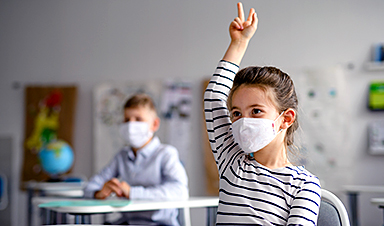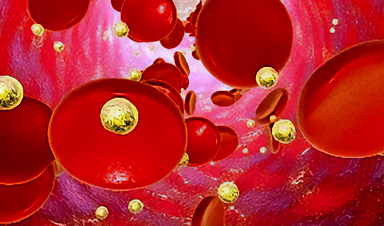A new study led by researchers at the University of Oxford’s Department of Computer Science has found that, between 2021 and 2022, COVID-19 was a leading cause of death in children and young people in the United States, ranking eighth overall. The results demonstrate that pharmaceutical and public health interventions should continue to be applied to limit the spread of the coronavirus and protect again severe disease in this age group.
The study indicates that pharmaceutical and public health interventions remain important to protect children and young people against COVID-19. Image credit: Shutterstock.
COVID-19 was the underlying cause of death for more than 940,000 people in the US, including over 1,300 deaths among children and young people aged 0–19 years. Until now, it had been unclear how the burden of deaths from COVID-19 compared with other leading causes of deaths in this age group.
The researchers investigated this using data from US Centers for Disease Control and Prevention databases for the period 1 August 2021 to 31 July 2022.
Key findings:
- Among children and young people aged 0 – 19 years in the US, COVID-19 ranked eighth among all causes of death; fifth among all disease-related causes of death; and first in deaths caused by infectious or respiratory diseases.
- By age group, COVID-19 ranked seventh (infants), seventh (1–4 year olds), sixth (5–9 year olds), sixth (10–14 year olds), and fifth (15–19 year olds).
- COVID-19 was the underlying cause for 2% of deaths in children and young people (800 out of 43,000), with an overall death rate of 1.0 per 100,000 of the population aged 0–19. The leading cause of death (perinatal conditions) had an overall death rate of 12.7 per 100,000; COVID-19 ranked ahead of influenza and pneumonia, which together had a death rate of 0.6 per 100,000.
- Like many diseases, COVID-19 death rates followed a U-shaped pattern across this age-range. COVID-19 death rates were highest in infants aged less than one year (4.3 per 100,000), second highest in those aged 15–19 years (1.8 per 100,000), and lowest in children aged 5 –9 years (0.4 per 100,000).
- Overall, deaths in children and young people were higher during the Delta and Omicron waves compared to previous waves (pre-July 2021), likely reflecting the higher numbers infected during these periods. Nevertheless, in the pre-Delta period of the pandemic, COVID-19 still ranked as the ninth leading cause of death overall.
- The month with the highest number of COVID-19 related deaths in 0 – 19 year-olds was January 2022 at 160.
Many of the 82 million American children and young people were infected during the big Delta and Omicron waves, and as a result more than 1,300 children and young people have died from COVID-19 during the pandemic, most in the last two years.
Associate Professor Seth Flaxman, Department of Computer Science, University of Oxford.
Although COVID-19 amplifies the impacts of other diseases (such as pneumonia and influenza), this study focuses on deaths that were directly caused by COVID-19, rather than those where COVID-19 was a contributing cause. Therefore, it is likely that these results understate the true burden of COVID-19 related deaths in this age-group.
Compared with other age-groups, the overall risk of death from COVID-19 was substantially lower in children and young people. For instance, between 1 August 2021 and 31 July 2022, the COVID-19 death rate among all ages in the US was 109 per 100,000. However, because deaths among children and young people in the US are rare, the mortality burden of COVID-19 is best understood in the context of all other causes of death in this age-group.
According to the researchers, these results suggest that, with variants of COVID-19 continuing to circulate, public health measures such as vaccinations, staying at home when sick, and ventilation still have an important role to play in limiting transmission of the virus and mitigating severe disease in children and young people.
Associate Professor Seth Flaxman (Department of Computer Science, University of Oxford), lead author of the study, said: ‘These results demonstrate that while it’s rare for kids and teens to die in the US, COVID-19 is now the leading underlying cause of death from infectious disease for this age group. Fortunately, we now have an array of effective tools to minimize risk, from building ventilation to air purifiers to safe vaccines. Working together, communities can significantly limit the extent of infection and severe disease.’
The study also involved researchers from Imperial College London, Queen Mary University of London, Columbia University, the National University of Singapore and the University of Copenhagen.
The full paper ‘Assessment of COVID-19 as the underlying cause of death among children and young people aged 0 to 19 years in the US’ can be read in the journal JAMA Network Open.
News
Nanocrystals Carrying Radioisotopes Offer New Hope for Cancer Treatment
The Science Scientists have developed tiny nanocrystal particles made up of isotopes of the elements lanthanum, vanadium, and oxygen for use in treating cancer. These crystals are smaller than many microbes and can carry isotopes of [...]
New Once-a-Week Shot Promises Life-Changing Relief for Parkinson’s Patients
A once-a-week shot from Australian scientists could spare people with Parkinson’s the grind of taking pills several times a day. The tiny, biodegradable gel sits under the skin and releases steady doses of two [...]
Weekly injectable drug offers hope for Parkinson’s patients
A new weekly injectable drug could transform the lives of more than eight million people living with Parkinson's disease, potentially replacing the need for multiple daily tablets. Scientists from the University of South Australia [...]
Most Plastic in the Ocean Is Invisible—And Deadly
Nanoplastics—particles smaller than a human hair—can pass through cell walls and enter the food web. New research suggest 27 million metric tons of nanoplastics are spread across just the top layer of the North [...]
Repurposed drugs could calm the immune system’s response to nanomedicine
An international study led by researchers at the University of Colorado Anschutz Medical Campus has identified a promising strategy to enhance the safety of nanomedicines, advanced therapies often used in cancer and vaccine treatments, [...]
Nano-Enhanced Hydrogel Strategies for Cartilage Repair
A recent article in Engineering describes the development of a protein-based nanocomposite hydrogel designed to deliver two therapeutic agents—dexamethasone (Dex) and kartogenin (KGN)—to support cartilage repair. The hydrogel is engineered to modulate immune responses and promote [...]
New Cancer Drug Blocks Tumors Without Debilitating Side Effects
A new drug targets RAS-PI3Kα pathways without harmful side effects. It was developed using high-performance computing and AI. A new cancer drug candidate, developed through a collaboration between Lawrence Livermore National Laboratory (LLNL), BridgeBio Oncology [...]
Scientists Are Pretty Close to Replicating the First Thing That Ever Lived
For 400 million years, a leading hypothesis claims, Earth was an “RNA World,” meaning that life must’ve first replicated from RNA before the arrival of proteins and DNA. Unfortunately, scientists have failed to find [...]
Why ‘Peniaphobia’ Is Exploding Among Young People (And Why We Should Be Concerned)
An insidious illness is taking hold among a growing proportion of young people. Little known to the general public, peniaphobia—the fear of becoming poor—is gaining ground among teens and young adults. Discover the causes [...]
Team finds flawed data in recent study relevant to coronavirus antiviral development
The COVID pandemic illustrated how urgently we need antiviral medications capable of treating coronavirus infections. To aid this effort, researchers quickly homed in on part of SARS-CoV-2's molecular structure known as the NiRAN domain—an [...]
Drug-Coated Neural Implants Reduce Immune Rejection
Summary: A new study shows that coating neural prosthetic implants with the anti-inflammatory drug dexamethasone helps reduce the body’s immune response and scar tissue formation. This strategy enhances the long-term performance and stability of electrodes [...]
Scientists discover cancer-fighting bacteria that ‘soak up’ forever chemicals in the body
A family of healthy bacteria may help 'soak up' toxic forever chemicals in the body, warding off their cancerous effects. Forever chemicals, also known as PFAS (per- and polyfluoroalkyl substances), are toxic chemicals that [...]
Johns Hopkins Researchers Uncover a New Way To Kill Cancer Cells
A new study reveals that blocking ribosomal RNA production rewires cancer cell behavior and could help treat genetically unstable tumors. Researchers at the Johns Hopkins Kimmel Cancer Center and the Department of Radiation Oncology and Molecular [...]
AI matches doctors in mapping lung tumors for radiation therapy
In radiation therapy, precision can save lives. Oncologists must carefully map the size and location of a tumor before delivering high-dose radiation to destroy cancer cells while sparing healthy tissue. But this process, called [...]
Scientists Finally “See” Key Protein That Controls Inflammation
Researchers used advanced microscopy to uncover important protein structures. For the first time, two important protein structures in the human body are being visualized, thanks in part to cutting-edge technology at the University of [...]
AI tool detects 9 types of dementia from a single brain scan
Mayo Clinic researchers have developed a new artificial intelligence (AI) tool that helps clinicians identify brain activity patterns linked to nine types of dementia, including Alzheimer's disease, using a single, widely available scan—a transformative [...]






















